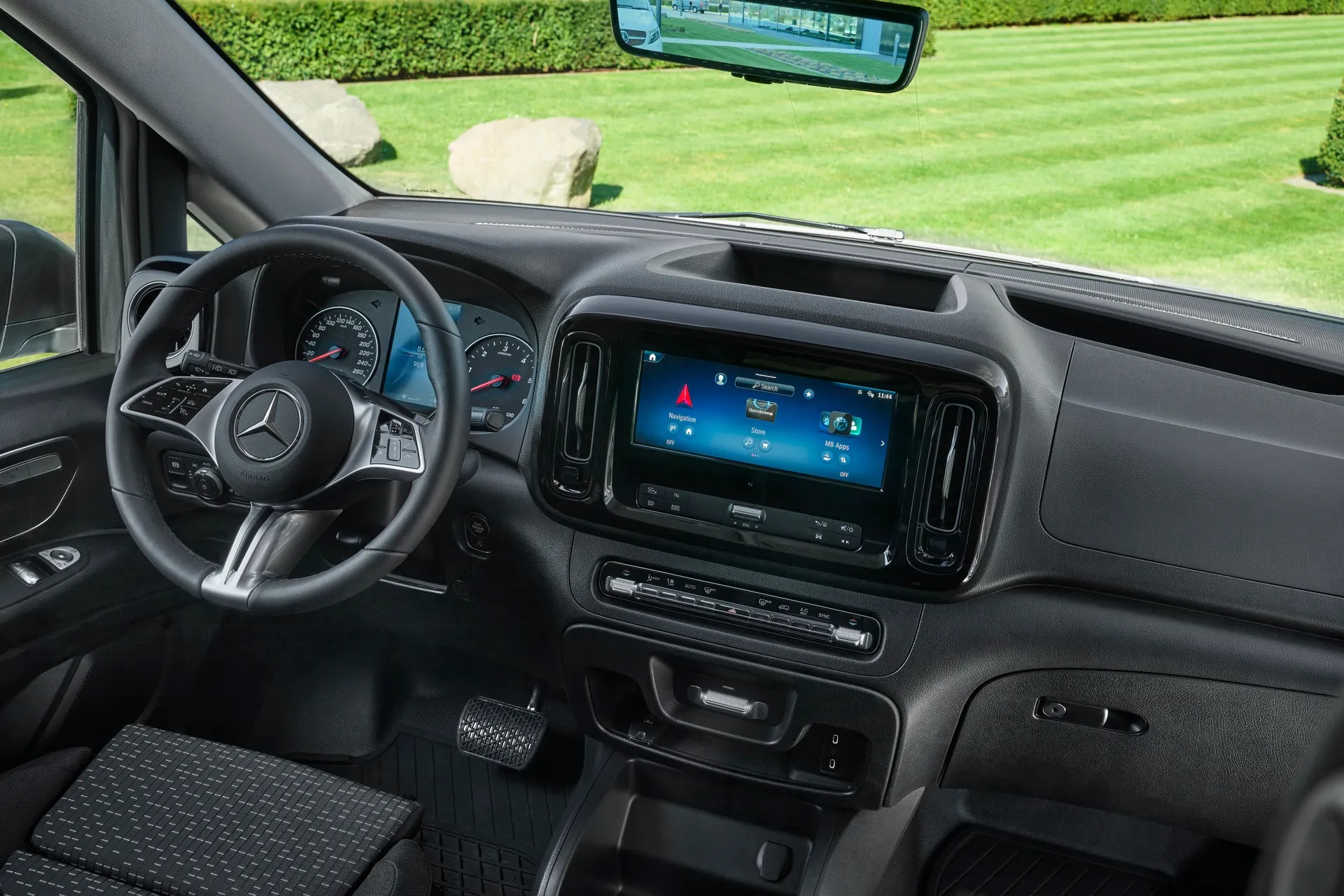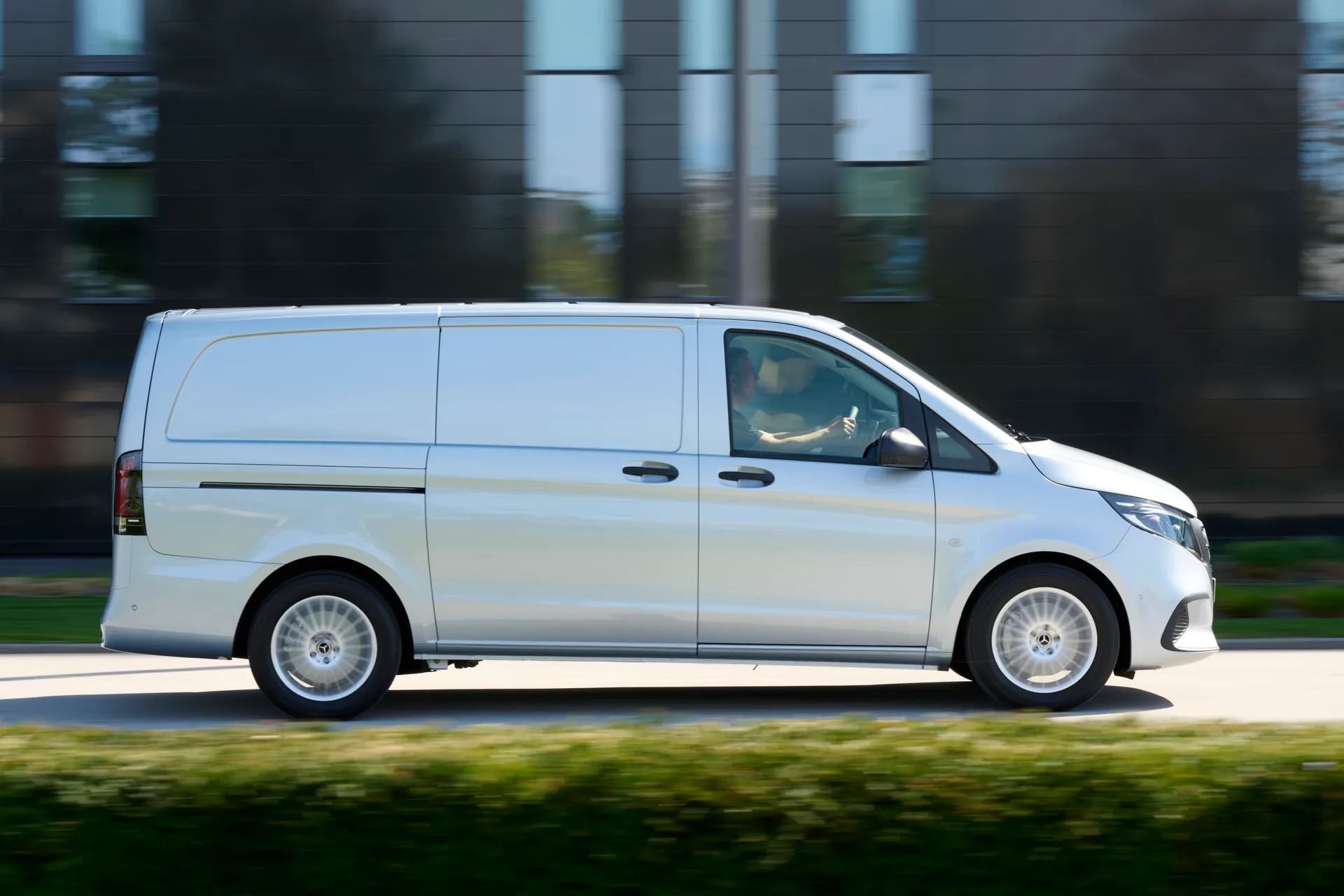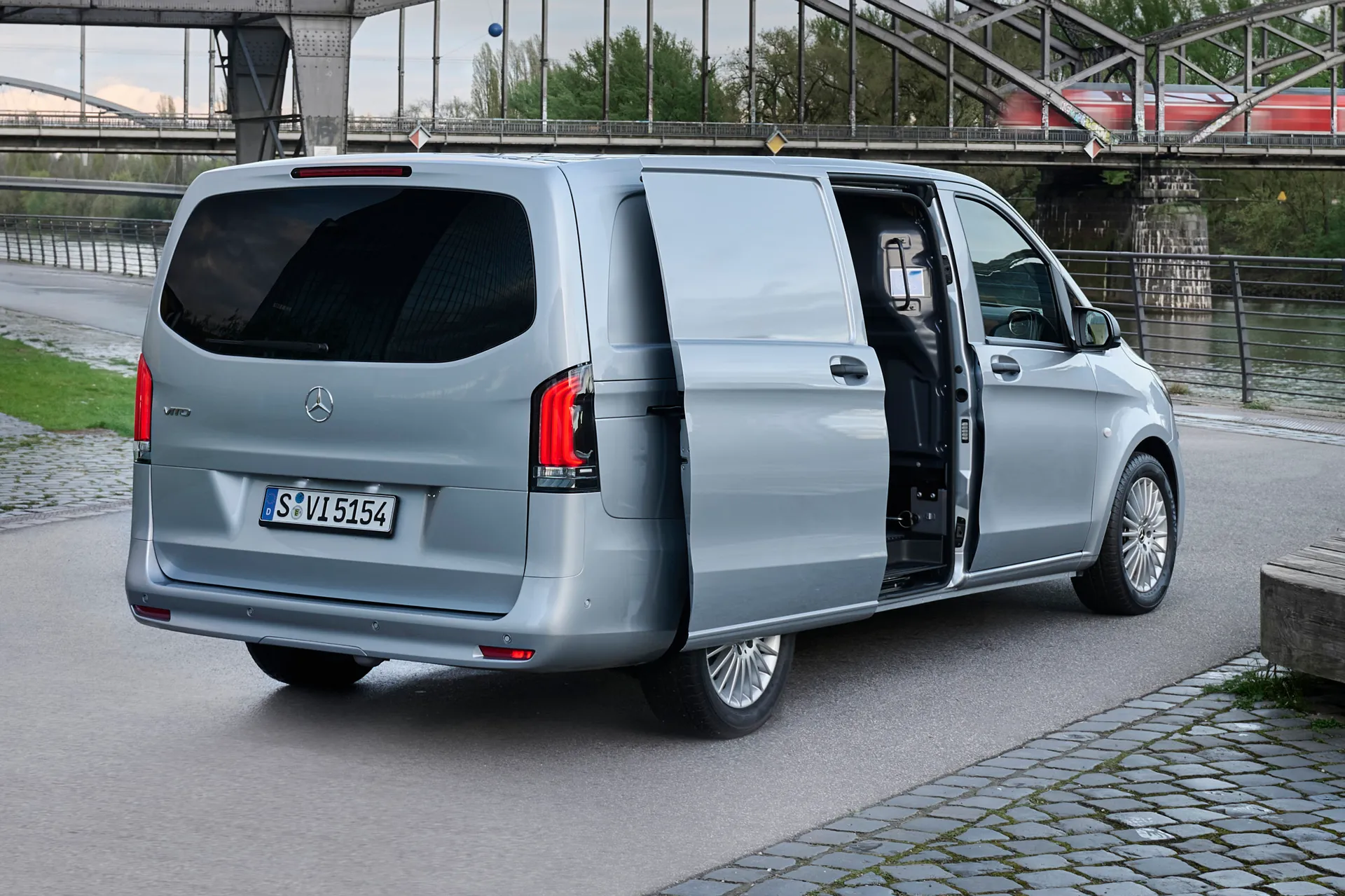Mercedes-Benz Vito Review 2024
Written by Ivan Aistrop
Quick overview
Pros
- Good to drive
- A cut above for interior quality
- Sheer desirability
Cons
- Some optional kit should be standard
- Rear-drive only, so payload could be higher
- Not a cheap option
Overall verdict on the Mercedes-Benz Vito
"A prestige badge and a high-grade interior make the Mercedes-Benz Vito a mid-size panel van that feels genuinely posh."

The Mercedes Vito has been a high-roller in the mid-size van game for some time, and not just because it’s a big seller that generates significant income for its maker. It’s also because it makes those who own and operate it feel like a high-roller as well. Find out why in our 2024 Mercedes-Benz Vito review.
This generation of Mercedes Vito has actually been around since 2015, but in the middle of 2024, it received a facelift, and the upgrades were so significant, and made such a difference, that we felt the latest incarnation needed its own separate review. If you’re looking for something a little older on the used van market, check out our review of the 2015-2023 Vito here.
Central to the 2024 updates is the new infotainment system, an area in which Mercedes has been smashing it in recent years. The Mercedes Vito received a version of the company’s revered MBUX system, albeit a rather more basic version, but it still delivers broad functionality and good ease-of-use. It also gives the Mercedes Vito a slightly more high-tech feel than you get in many vans, and that helps towards the Vito’s inherent feeling of sophistication.
So do two other things. Firstly, there’s the three-pointed star on the nose, which not only makes the owner/operator feel like something a bit special, but it also has the beneficial by-product of immediately conjuring up impressions of success and prosperity in the minds of you customers and clients as you roll up for jobs.
And then there’s the quality of the interior. Granted, like in pretty much all other vans, the materials used are more focused on durability than tactility, and are therefore less appealing to the fingertips than they are in the firm’s passenger cars. Compared with rivals in the commercial vehicle sector, though, it’s a real cut above.
It’s a sophisticated-feeling thing to drive, too. The ride is perhaps a little bit firmer than you might expect, but it feels stable and assured on the road, and there are never any nasty surprises in the way it behaves. The three diesel engines on offer - there’s an all electric version, too, which will get its own review once we’ve driven it - do a good job on economy and refinement, and the most powerful one (which is the only one we’ve tried so far) delivers brawny, eager performance.
Importantly for any panel van (it’s available with three seats in the front, or as a crew van with an extra row of seats behind), it does a very reasonable job in terms of load-carrying: it’s not class-leasing for load volume or payload, but it is competitive.
And granted, it’s not cheap in the scheme of things, but neither is it outrageously expensive compared with more mainstream rivals, and you do get a very decent slice of standard equipment for your money. Overall, it’s a very compelling package for any owner/operator looking for a commercial vehicle with a little something extra about it.
Looking for a used van for sale? We've got 100s of Mercedes-Benz Approved Used Cars for Sale for you to choose from, including a wide range of Mercedes Vito vans for sale.
Is the Mercedes-Benz Vito right for you?
If you or your business is in need of a mid-size van, but you want it to feel like a cut above in terms of quality because you’ll be spending working day after working day in it, then the Mercedes Vito is definitely for you. It’s also a good choice if you want your work transport to create the right impression with customers and clients. After all, even where vans are concerned, few automotive badges communicate success like a Mercedes badge.
What’s the best Mercedes-Benz Vito model/engine to choose?
So far, we’ve only had a go in a Mercedes Vito with the range-topping 119 engine option, which is a 2.0-litre unit with 190PS delivered to the rear wheels via a nine-speed automatic gearbox. There’s a lot to like about how it operates, but it’s the priciest option there is, and having not tried them, we can’t say for sure whether the lesser versions will suffice.
Trim wise, most of the upgrades that Select trim gets you over the Pro are aesthetic, so we’d probably stick with the entry-level version and save a few quid. And in terms of whether you go for the panel van or the crew cab, that depends entirely on your needs and what you’ll be using the van for.
What other vans are similar to the Mercedes-Benz Vito?
The Mercedes Vito competes in the mid-size van market, which is densely populated and ultra-competitive. Probably the closest rival in terms of being a premium option is the Volkswagen Transporter, while the biggest-selling vehicle in the sector - and incidentally, the entire motor industry - is the all-conquering (and brilliant) Ford Transit Custom.
There’s a lot of technology and parts-sharing between companies that goes on in this area of the market, and so many of the offerings are closely related to each other. The Renault Trafic and the Nissan Interstar have plenty in common, for instance, while the Stellantis stable offers the Citroen Dispatch, the Peugeot Expert, Vauxhall Vivaro and Fiat Scudo and the Toyota Proace (which is mechanically identical despite Toyota not being part of Stellantis).
Comfort and design: Mercedes-Benz Vito interior
"Like in most mid-size vans, you get a proper king-of-the-road driving position due to how high you sit above the road, and it’s easy to see where the extremities of your bonnet are for manoeuvring."

Concerning your rear view, you don’t really have one in the panel van version outside of what you can see in your heated- and electrically adjusting door mirrors, but when you’re parking, you have the help of a rear-view camera on all versions. In the crew van version, there is a window in the rear tailgate, complete with rear wash/wipe, but even here, your view isn’t great because it’s impaired by the high-set headrests on the rear seats.
There’s a reasonable amount of adjustment for the driver’s seats, plus rake and reach adjustment on the steering column, so drivers of all shapes and sizes should be able to get themselves comfy.
Most of the switches on the dashboard are shortcut buttons for the infotainment system, but it is good that you have a row of physical buttons and switches to operate the ventilation system so you don’t have to go traipsing through on-screen menus. It is slightly irritating, though, that the vast smattering of touch-sensitive controls on the steering wheel are easy to brush by accident, thus instigating an action you never intended.
The instrument dials are traditional analogue ones with a 5.5-inch digital display inset between them, and they’re very clear and easy to read.
Quality and finish
Commercial vehicles always feel rather less posh than their passenger car counterparts, and the same is true of the Vito. Where the materials in most areas are soft and sumptuous in, say, a C-Class, they’re harder and more durable in the Vito. This is utterly expected and perfectly forgivable, because you’d much rather have hard-wearing panels that will shrug off the effects of hard daily use, rather than plusher ones that would mark up at the first sign of contact. And because Mercedes products generally have a higher bar in terms of quality than most other manufacturers of mid-size vans, the interior in the Vito still feels a good bit posher than it does in most rivals.
That’s helped by a few thoughtful splashes of chrome trim and glossy piano black panelling dotted around the place to break up the swathes of plastic, and it’s really effective. The circular air vents are similar to those you’ll find in the firm’s passenger cars as well, while the same goes for the slickly operating ventilation controls, and this all helps lift the ambience inside the Vito still further.
Infotainment: Touchscreen, USB, nav and stereo in the Mercedes-Benz Vito
The infotainment system was one of the major upgrades brought about by the Vito’s 2024 facelift. It’s a version of the company’s impressive MBUX system, albeit a less sophisticated one than that found in most of Merc’s passenger cars. It operates through a 10.25-inch central touchscreen, and supports functions like Bluetooth, DAB radio and Apple CarPlay/Android Auto. If you want native satnav instead of streaming navigation instructions through the screen from your phone, it’s an optional extra across the board, as is wireless phone charging.
The system is reasonably easy to find your way around, and the screen reacts reliably and swiftly to prods and swipes. A couple of more peripheral functions can be a little difficult to locate within the menu structure, though, and the voice control system isn’t as good as it is on other versions of MBUX.
Space and practicality: Mercedes-Benz Vito load space
Let’s kick things off in this area with the all-important bit for many, and that’s the dimensions. Two length options are available with the Vito, the L1 and L2. There are also two seating layouts available: the regular panel van has three seats up front, while the crew van variant sacrifices a chunk of its loadspace to accommodate an extra row of three seats behind.
All versions of the Vito measure 2,244mm wide. The panel van measures 1,915mm tall when unladen, while crew van variants are a few millimetres lower in this regard, presumably due to the weight of the extra seats pressing down on the suspension springs.
The biggest variable between the various versions is length, both in terms of vehicle itself and of the loadbay. L2 Vitos are 5,140mm long, while L3 versions are 230mm longer, and all of that extra length lies in the wheelbase (the distance between the front and rear wheels).
In all Vitos, the loadbay measures 1,252mm high and 1,270mm wide between the wheelarches. In panel van variants the loadbay in the L2 measures 2,831mm in length, giving an overall load capacity of 6.0 cubic metres, while in L3 versions, the loadbay length is 3,061mm, taking the loadbay volume up to 6.6 cubic metres.
With the crew van variant, the loadbay is considerably shorter due to the extra seats. In the L2, it’s 1,644mm long, giving an overall loading capacity of 3.6 cubic metres, while in the L3, loadbay length is 1,894mm, giving a capacity of 4.1 cubic metres.
In panel vans, the loadbay has a wood lining, while in the crew van, you get a hard-wearing plastic lining and a generally more civilised interior trim.
The gross vehicle weight (GVW) of all Vitos is 3,000kg. In terms of payload, they’re between 790kg and 903kg on the panel van, and between 739kg and 790kg on the crew van. It’s not quite a perfect science, but generally speaking, the lower the spec of your van, the higher its payload.
Panel van versions of the Vito get twin side-hinged doors on the back end that can open up to 180 degrees for better access to the loadspace, while crew van versions get a single massive top-hinged tailgate instead, which could prove more tricky to get open if your work is taking place in a tight space. All Vitos also get a pair of sliding side doors, but on crew van variants, these are more for access to the rear seats than they are for access to the loadbay.
The Vito we tried was a crew van, and we can confirm that there’s masses of headroom and legroom in those rear seats, so tall folk will be able to stretch out. We actually think there might be a little too much in the way of legroom, and that the rear seats could have been mounted a little further forward in the interests of prioritising loadspace. However, the rear seats in the crew van can be removed (if you’re strong enough) to restore your loadspace to parity with the panel van.
Up front, meanwhile, the three seats are wide enough to accommodate a generously proportioned adult posterior, and there’s enough width in the cabin to accommodate three seats of shoulders without the owners of them having to get too cosy with each other.
Handling and ride quality: What is the Mercedes-Benz Vito like to drive?
"It’s perhaps a little unreasonable to expect the Vito to ride and handle like one of Mercedes-Benz’s luxury limousines, but it does a very decent job in both departments."

In terms of ride comfort, the suspension is perhaps a little firmer than you might expect, so there are some rival mid-size vans that’ll provide a plusher ride. However, it never gets to the point where you feel uncomfortable, and things settle down a bit more when you load it up with some extra weight in the loadbay. Get yourself at a steady motorway cruise, meanwhile, and it feels as settled and as stable as you could hope.
The handling feels very tidy and assured, too. The Mercedes Vito has very decent control over its body movements, so the van doesn’t lurch about as you change direction, as long as those direction changes are conducted at a reasonable speed. The steering is nicely weighted and very responsive, and the turning circle feels tighter than you might expect, so low-speed manoeuvres don’t take too much arm-flailing.
What engines and gearboxes are available in the Mercedes-Benz Vito?
There is an all-electric version of the Mercedes Vito, called the eVito (sounds a bit like a musical, doesn’t it?!), but we’ll be dealing with that in a separate review. So here, we’ll just concentrate on the various diesel-powered versions available.
There are three of them, all powered by the same 2.0-litre four-cylinder turbodiesel engine. The entry-level choice is known as the 114, and it delivers 136PS to the rear wheels, and comes with a six-speed manual gearbox. This choice is only available on the panel van and not on the crew van.
The 116 variant is available on both, and it ups the power ante to 163PS and adds a nine-speed automatic gearbox for good measure. The range-topping 119 gets the same transmission, but hikes the output to 190PS.
We’ve so far only had the chance to try the most powerful 119 variant, and it does a good job. It feels pleasantly brawny when putting on speed and maintaining it, so your progress is always easy and relaxed.
Your pace is perhaps slightly hampered by the rather slow reactions of the automatic gearbox, mind. It’s rather reluctant to shift down when you want to pick up the pace a little bit, leaving you in the doldrums slightly. You’ll also find yourself pressing the accelerator pedal harder than you wanted to in order to provoke it into a gearchange, and that means that when the gearbox finally does kick down, the engine is working harder than it should be.
You can get around this partially by selecting the Sport driving mode (why a van even has such a thing is beyond us!), but this remedies the gearboxes reluctance to change down, it also has the reverse effect of making the transmission reluctant to shift up, and that means things are noisier than they need to be.
Having not tried the lesser versions yet, we can’t really say how they compare for performance, and because Mercedes doesn’t publish performance figures for the Mercedes Vito, we can’t even make an educated guess. We’ll just have to try and get a go in them and update this review once we manage it.
Refinement and noise levels
The diesel engine we tried stayed hushed and smooth the majority of the time, and while we’ve just discussed the circumstances in which it can get a little louder, it never got overly intrusive. And while the reactions of the automatic gearbox could be quicker, the gearchanges are usually smooth and fuss-free.
Wind- and road noise are pretty well suppressed at the legal motorway limit, too, so long cross-country schleps won’t be something you want to avoid in the Mercedes Vito if that’s where the work takes you.
Safety equipment: How safe is the Mercedes-Benz Vito?
As standard throughout the range, the Mercedes Vito comes with automatic emergency braking, attention assist, active lane keep assist, blind spot assist, intelligent speed limit assist, and eCall function to automatically alert the emergency services with your precise location in the event of an accident.
Mercedes has worked to improve the driver assistance systems in the updated 2024 Mercedes Vito, and it seems this work has paid off. The previous Mercedes Vito was subjected to Euro NCAP’s commercial vehicle tests (these are more to do with the provision and effectiveness of preventative driver assistance systems, rather than the vehicle’s crash protection) under the body’s 2023 protocols, and was awarded Silver status. The latest version, however, tested against tougher 2024 protocols, and earned Platinum status, the highest rating you can get. It also achieved one of the highest scores for Safety Assist Performance that we’ve seen at 90%.
That said, while you get twin front airbags as standard, you have to pay extra if you want side- and curtain airbags. Adaptive cruise control is also optional across the board.
MPG and fuel costs: What does a Mercedes-Benz Vito cost to run?
"Despite the various engines, transmissions and body styles available within the Vito range, there’s actually surprisingly little variation in the official WLTP fuel consumption between the various versions."

"Despite the various engines, transmissions and body styles available within the Mercedes Vito range, there’s actually surprisingly little variation in the official WLTP fuel consumption between the various versions."
The best figure on offer comes on the lowest-spec versions of the panel van and stands at 39.2mpg, but even the thirstiest one returns 38.1mpg. The cleanest version of the crew cab, meanwhile, returns 38.6mpg according to the figures, while the grubbiest still manages 37.6mpg.
It would seem that fuel economy isn’t much of a factor when choosing an engine for your Vito, so just pick the pokiest one you can afford.
Obviously, the electric version of the Mercedes Vito doesn’t use any fuel at all, but we’ll deal with that vehicle in a separate review.
How reliable is the Mercedes-Benz Vito?
Vans aren’t featured in our go-to source for reliability data, the HonestJohn.co.uk Satisfaction Index, run by our sister website. That means it’s difficult to talk about the Vito specifically.
As a brand, however, Mercedes-Benz didn’t exactly cover itself in glory in the latest study. The German firm was voted as the sixth worst brand in the entire study for reliability specifically, while for overall customer satisfaction, the company placed a lowly 20th out of the 29 carmakers considered.
Maybe it’s a good thing, then, that Mercedes provides a slightly better-than-average warranty on the Vito. There’s only three years of cover, which isn’t as generous as some, but there’s no mileage limit, either.
Insurance groups and costs
Insurance groupings for the Mercedes-Benz Vito run from 27 to 44 depending on the particular version you have. Obviously, that’s not the only factor that influences your insurance costs, so there are other measures you can take to cut premiums, such as locking it away in a garage or warehouse overnight, and maybe installing additional security measures.
VED car tax: What is the annual road tax on a Mercedes-Benz Vito?
As a light goods vehicle, the Mercedes Vito is liable for a flat rate of VED tax for such vehicles. This is currently charged at £335 per year. You’ll pay just over £350 if you elect to pay in instalments by direct debit, though, and around £370 if you choose to pay every six months rather than every year. As a result, it’s better to pay the single annual lump sum if you can.
How much should you be paying for a used Mercedes-Benz Vito?
"If you’re buying a brand new Vito in a manner that requires paying VAT, then prices start at around £40,000 for the lowest-spec panel van, while the cheapest crew van starts at £49,000, although most of that price difference is down to the fact that the crew van isn’t available with the entry-level engine and gearbox option."

At the top of the range, prices extend up to £53,000 for the panel van, and to £55,000 for the crew van.
The updated 2024 version of the Mercedes Vito is rather too new for pre-owned examples to be readily available on the used car market just yet. It might be worth milling around your local Mercedes commercial vehicle retailer, though, just in case they have pre-registered examples or ex-demonstrators kicking about the place.
If you can live without the 2024 updates to the infotainment system, safety systems and all the rest of it, then you’ll obviously have an incredibly wide choice of pre-facelift Vitos, which are all but mechanically identical to the latest one. These start at around £12,000 or £13,000 if you don’t mind a somewhat interstellar mileage, and a budget of around £20,000 will get you a broad choice of panel vans and crew cabs in a variety of specs.
Trim levels and standard equipment
There are two trim levels available with the Vito, Pro and Select, the Pro being the more basic of the pair, but the precise level of kit you get with each varies ever so slightly depending on whether you’re talking about the panel van or the crew van. Let’s look at the former first.
The Pro still gets all the essentials in the panel van, and a half-decent amount of luxury gear, too, including air-conditioning, cruise control, a multi-function steering wheel, and a reversing camera. Of course, that’s on top of all the safety kit and infotainment stuff we talked about earlier on.
Select versions look a little sharper from the outside with alloy wheels, body-coloured bumpers, metallic paint and a few additional chrome trims, while you also get power folding door mirrors, multibeam LED headlights with automatic high beam, and a parking package. The interior also gets a few additional splashes of chrome, along with a leather steering wheel and interior ambient lighting.
Crew van models are broadly similar, except for the fact that Pro models get alloy wheels and body-coloured bumpers for a slightly smarter look from the outside, while they also get a tailgate on the rear instead of the twin rear doors, and the interior trim is also smarter, with the loadbay being finished in plastic rather than wood.
Interestingly, leatherette upholstery is a very cheap option on all Vitos, and so is a very affordable way to instantly make your van feel that little bit posher. However, this option costs slightly more on the crew van because there are more seats to cover.
Ask the heycar experts: common questions
Is the Mercedes Vito a van?
Is the Mercedes Vito any good?
Is the Mercedes Vito the same as the Renault Trafic?
Get our latest advice, news and offers
Keep me updated by email with the latest advice, news and offers from heycar.
By submitting you agree to our privacy policy



